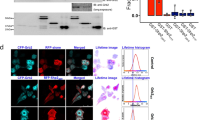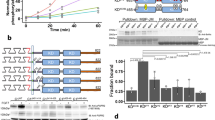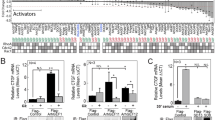Abstract
When growth hormone binds to its receptor, which belongs to the cytokine receptor superfamily1, it activates the Janus kinase Jak22 which has tyrosine-kinase activity and initiates an activation of several key intracellular proteins (for example, mitogen-activated protein (MAP) kinases3,4,5,6) that eventually execute the biological actions induced by growth hormone, including the expression of particular genes. In contrast to receptors that themselves have tyrosine kinase activity, the signalling pathways leading to MAP kinase activation7,8 that are triggered by growth hormone are poorly understood, but appear to be mediated by the proteins Grb2 and Shc9. We now show that growth hormone stimulates tyrosine phosphorylation of the receptor for epidermal growth factor (EGFR) and its association with Grb2 and at the same time stimulates MAP kinase activity in liver, an important target tissue of growth hormone. Expression of EGFR and its mutants revealed that growth-hormone-induced activation of MAP kinase and expression of the transcription factor c-fos requires phosphorylation of tyrosines on EGFR, but not its own intrinsic tyrosine-kinase activity. Moreover, tyrosine at residue 1,068 of the EGFR is proposed to be one of the principal phosphorylation sites and Grb2-binding sites stimulated by growth hormone via Jak2. Our results indicate that the role of EGFR in signalling by growth hormone is to be phosphorylated by Jak2, thereby providing docking sites for Grb2 and activating MAP kinases and gene expression, independently of the intrinsic tyrosine kinase activity of EGFR. This may represent a novel cross-talk pathway between the cytokine receptor superfamily and growth factor receptor.
This is a preview of subscription content, access via your institution
Access options
Subscribe to this journal
Receive 51 print issues and online access
$199.00 per year
only $3.90 per issue
Buy this article
- Purchase on Springer Link
- Instant access to full article PDF
Prices may be subject to local taxes which are calculated during checkout




Similar content being viewed by others
References
Ihle, J. N. et al. Signaling by the cytokine receptor superfamily: JAKs and STATs. Trends Biochem. Sci. 19, 222–227 (1994).
Argetsinger, L. S. et al. Identification of JAK2 as a growth hormone receptor-associated tyrosine kinase. Cell 74, 237–244 (1993).
Frank, S. J. et al. Regions of the JAK2 tyrosine kinase required for coupling to the growth hormone receptor. J. Biol. Chem. 270, 14765–14785 (1995).
Winston, L. A. & Hunter, T. JAK2, Ras, Raf are required for activation of extracellular signal-regulated kinase/mitogen-activated protein kinase by growth hormone. J. Biol. Chem. 270, 30837–30840 (1995).
Han, Y. et al. Participation of JAK and STAT proteins in growth hormone-inducing signaling. J. Biol. Chem. 271, 5947–5952 (1996).
Ihle, J. N. STATs and MAPKs: obligate or opportunistic partners in signaling. BioEssays 18, 95–98 (1996).
Burgering, B. M. T. & Bos, J. L. Regulation of Ras-mediated signalling: more than one way to skin a cat. Trends Biochem. Sci. 20, 18–22 (1995).
van Biesen, T. et al. Receptor-tyrosine-kinase- and Gβγ-mediated MAP kinase activation by a common signalling pathway. Nature 376, 781–784 (1995).
VanderKuur, J., Allevato, G., Billestrup, N., Norstedt, G. & Carter-Su, C. Growth hormone-promoted tyrosyl phosphorylation of Shc proteins and Shc association with Grb2. J. Biol. Chem. 270, 7587–7593 (1995).
Ridderstrale, M., Degerman, E. & Tornqvist, H. Growth hormone stimulates the tyrosine phosphorylation of the insulin receptor substrate-1 and its association with phosphatidylinositol 3-kinase in primary adipocytes. J. Biol. Chem. 270, 3471–3474 (1995).
Argetsinger, L. S. et al. Growth hormone, interferon-γ, and leukemia inhibitory factor promoted tyrosyl phosphorylation of insulin receptor substrate-1. J. Biol. Chem. 270, 14685–14692 (1995).
Argetsinger, L. S., Norstedt, G., Billestrup, N., White, M. F. & Carter-Su, C. Growth hormone, interferon-γ, and leukemia inhibitory factor utilize insulin receptor substrate-2 in intracellular signaling. J. Biol. Chem. 271, 29415–29421 (1996).
Tamemoto, H. et al. Insulin resistance and growth retardation in mice lacking insulin receptor substrate-1. Nature 372, 182–186 (1994).
Araki, E. et al. Alternative pathway of insulin signalling in mice with targeted disruption of the IRS-1 gene. Nature 372, 186–190 (1994).
Yamauchi, T. et al. Insulin signalling and insulin actions in the muscle and liver of insulin resistant IRS-1 deficient mice. Mol. Cell. Biol. 16, 3074–3084 (1996).
Miyake, S. et al. Efficient generation of recombinant adenoviruses using adenovirus DNA-terminal protein complex and a cosmid bearing the full-length virus genome. Proc. Natl Acad. Sci. USA 93, 1320–1324 (1996).
Sekine, N., Ullrich, S., Regazzi, R., Pralong, W. F. & Wollheim, C. B. Postreceptor signaling of growth hormone and prolactin and their effects in the differentiated insulin-secreting cell line, INS-1. Endocrinology 137, 1841–1850 (1996).
Batzer, A. G., Rotin, D., Urena, J. M., Skolnik, E. Y. & Schlessinger, J. Hierarchy of binding sites for Grb2 and Shc on the epidermal growth factor receptor. Mol. Cell. Biol. 14, 5192–5201 (1994).
Okutani, T. et al. Grb2/Ash binds directly to tyrosine 1068 and 1086 and indirectly to tyrosine 1148 of activated human epidermal growth factor receptors in intact cells. J. Biol. Chem. 269, 31310–31314 (1994).
Chen, C., Clarkson, R. W. E., Xie, Y., Hume, D. A. & Waters, J. M. Growth hormone and colony-stimulating factor-1 share multiple response elements in the c-fos promoter. Endocrinology 136, 4505–4516 (1995).
Wen, Z., Zhong, Z. & Darnell, J. E. J Maximal activation of transcription by Stat1 and Stat3 requires both tyrosine and serine phosphorylation. Cell 82, 241–250 (1995).
Gille, H., Sharrocks, A. D. & Shaw, P. E. Phosphorylation of transcription factor p62TCF by MAP kinase stimulates ternary complex formation at c-fos promoter. Nature 358, 414–417 (1992).
Watanabe, S., Itoh, T. & Arai, K. JAK2 is essential for activation of c-fos and c-myc promoters and cell proliferation through the human granulocyte-macrophage colony-stimulating factor receptor in BA/F3 cells. J. Biol. Chem. 271, 12681–12686 (1996).
Luttrell, L. M., Rocca, G. J. D., Biesen, T. V., Luttrel, D. K. & Lefkowitz, R. J. Gβγ subunits mediate src-dependent phosphorylation of the epidermal growth factor receptor. J. Biol. Chem. 272, 4637–4644 (1997).
Sachsenmaier, C. et al. Involvement of growth factor receptors in the mammalian UVC response. Cell 78, 963–972 (1994).
Daub, H., Weiss, F. U., Wallasch, C. & Ullrich, A. Role of transactivation of the EGF receptor in signalling by G-protein-coupled receptors. Nature 369, 557–560 (1996).
Honegger, A. M. et al. Point mutation at the ATP binding site of EGF receptor abolishes protein-tyrosine kinase activity and alters cellular routing. Cell 51, 199–209 (1987).
Okabayashi, Y. et al. Tyrosines 1148 and 1173 of activated human epidermal growth factor receptors are binding sites of Shc in intact cells. J. Biol. Chem. 269, 18674–18678 (1994).
Meunier-Durmort, C., Ferry, N., Hainque, B., Delattre, J. & Forest, C. Efficient transfer of regulated genes in adipocytes and hepatoma cells by the combination of liposomes and replication-deficient adenovirus. Eur. J. Biochem. 237, 660–667 (1996).
Tanaka, T. et al. Evi-1 raises AP-1 activity and stimulates c-fos promoter transactivation with dependence on the second zinc finger domain. J. Biol. Chem. 269, 24020–24026 (1994).
Acknowledgements
We thank I. Kerr and G. Stark for γ2A/GHR, C. Wollheim for INS-1, H. Green for 3T3 F442A cells, J. Ihle for Jak2 cDNA, K. Arai for expression vectors of Jak2 and dominant-negative Jak2 (ΔJak2), H. Sabe for Csk expression vector, I. Saitoh for Adex1CALacZ and the expression cosmid cassette, Y. Okabayashi and M. Kasuga and S. Kakinuma for technical assistance. This work was supported by grants from the research fellowships of the Japan Society for the Promotion of Science for Young Scientists (to T.Y.), from the Ministry of Education, Science, Sports, and Culture and the Ministry of Health and Welfare of Japan (to T.K.) and for diabetes research from the Taisho Pharmaceutical Co. Ltd. (to T.K.).
Author information
Authors and Affiliations
Corresponding author
Rights and permissions
About this article
Cite this article
Yamauchi, T., Ueki, K., Tobe, K. et al. Tyrosine phosphorylation of the EGF receptor by the kinase Jak2 is induced by growth hormone. Nature 390, 91–96 (1997). https://doi.org/10.1038/36369
Received:
Accepted:
Issue Date:
DOI: https://doi.org/10.1038/36369
This article is cited by
-
The significance of ErbB2/3 in the conversion of induced pluripotent stem cells into cancer stem cells
Scientific Reports (2022)
-
Targeting growth hormone function: strategies and therapeutic applications
Signal Transduction and Targeted Therapy (2019)
-
A growth hormone receptor SNP promotes lung cancer by impairment of SOCS2-mediated degradation
Oncogene (2018)
-
PAK1 is a breast cancer oncogene that coordinately activates MAPK and MET signaling
Oncogene (2012)
-
Regulation of PMA-induced MUC5AC expression by heparin in human bronchial epithelial cells
Molecular and Cellular Biochemistry (2012)
Comments
By submitting a comment you agree to abide by our Terms and Community Guidelines. If you find something abusive or that does not comply with our terms or guidelines please flag it as inappropriate.



